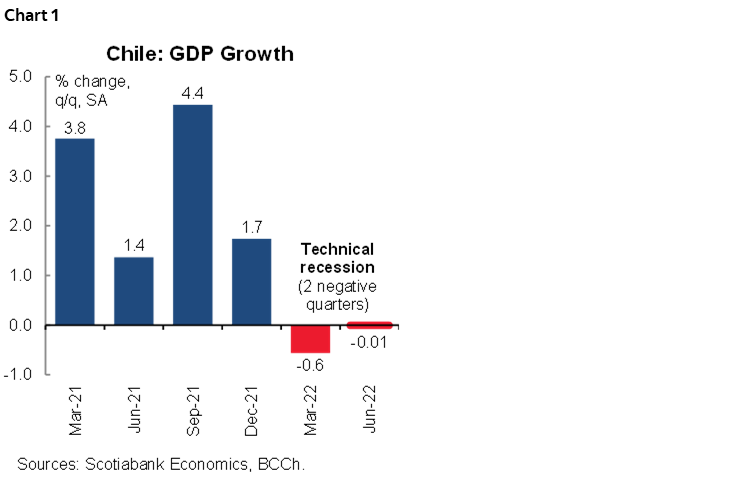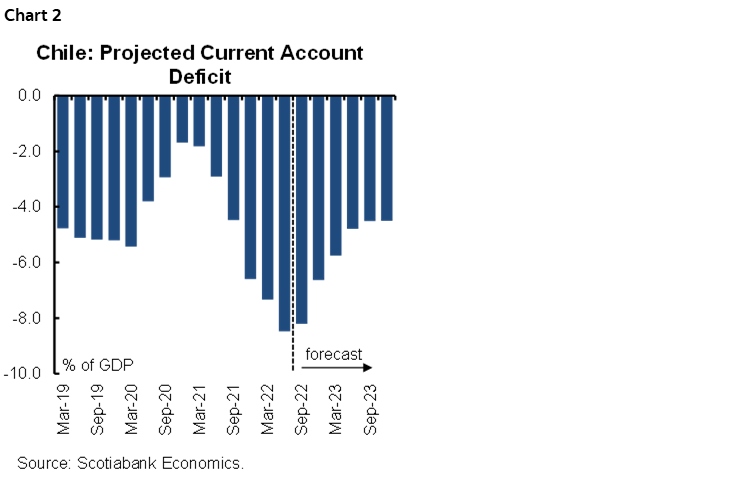- Chile: The worst of the current account deficit (8.5% of GDP) is behind
CHILE: THE WORST OF THE CURRENT ACCOUNT DEFICIT (8.5% OF GDP) IS BEHIND
On Thursday, August 18, the central bank (BCCh) released GDP growth for the second quarter of 2022, which expanded 5.4% y/y, less than previously estimated based on monthly GDP growth (5.7% y/y). In seasonally adjusted terms, economic activity fell 0.01% q/q due to negative contributions from the service and trade sectors. With this, the economy fell into its first technical recession since the first quarter of 2017 (chart 1). By components, total consumption fell 2.5% q/q due to the slowdown in both private consumption—mainly goods—and government consumption. At the same time, total investment decreased 1% q/q, thanks to the expected drop in its machinery and equipment components and the lack of dynamism in investment in construction. In turn, inventories grew strongly, partially offsetting the drop in consumption and investment. Considering all of the above, we incorporate a mild downward bias in our GDP growth forecast of 2.1% for this year and reiterate our forecast of -0.9% for 2023.

For its part, the current account deficit expanded to 8.5% of GDP during the second quarter of 2022 (from 7.3% of GDP in the first quarter), worse than expected by Scotiabank Economics (8% of GDP) but marking a turning point according to our projections. According to the BCCh, the current account deficit was explained by a deterioration in the trade balance in the second quarter, mainly due to an increase in imports of goods. To the extent that imports begin to reflect the slowdown in domestic demand, we expect a slight improvement in the external accounts in the coming quarters. Along the same lines, as we mentioned in our Latam Insights on July 27, we have probably already seen the worst in terms of the current account deficit in the second quarter of 2022. We expect a smooth but persistent convergence of the current account deficit towards sustainable levels in the coming quarters. With this, the current account deficit would converge to 6.6% of GDP by the end of 2022 and 4.5% of GDP by 2023, levels even lower than those observed at the beginning of 2019 (chart 2).

DISCLAIMER
This report has been prepared by Scotiabank Economics as a resource for the clients of Scotiabank. Opinions, estimates and projections contained herein are our own as of the date hereof and are subject to change without notice. The information and opinions contained herein have been compiled or arrived at from sources believed reliable but no representation or warranty, express or implied, is made as to their accuracy or completeness. Neither Scotiabank nor any of its officers, directors, partners, employees or affiliates accepts any liability whatsoever for any direct or consequential loss arising from any use of this report or its contents.
These reports are provided to you for informational purposes only. This report is not, and is not constructed as, an offer to sell or solicitation of any offer to buy any financial instrument, nor shall this report be construed as an opinion as to whether you should enter into any swap or trading strategy involving a swap or any other transaction. The information contained in this report is not intended to be, and does not constitute, a recommendation of a swap or trading strategy involving a swap within the meaning of U.S. Commodity Futures Trading Commission Regulation 23.434 and Appendix A thereto. This material is not intended to be individually tailored to your needs or characteristics and should not be viewed as a “call to action” or suggestion that you enter into a swap or trading strategy involving a swap or any other transaction. Scotiabank may engage in transactions in a manner inconsistent with the views discussed this report and may have positions, or be in the process of acquiring or disposing of positions, referred to in this report.
Scotiabank, its affiliates and any of their respective officers, directors and employees may from time to time take positions in currencies, act as managers, co-managers or underwriters of a public offering or act as principals or agents, deal in, own or act as market makers or advisors, brokers or commercial and/or investment bankers in relation to securities or related derivatives. As a result of these actions, Scotiabank may receive remuneration. All Scotiabank products and services are subject to the terms of applicable agreements and local regulations. Officers, directors and employees of Scotiabank and its affiliates may serve as directors of corporations.
Any securities discussed in this report may not be suitable for all investors. Scotiabank recommends that investors independently evaluate any issuer and security discussed in this report, and consult with any advisors they deem necessary prior to making any investment.
This report and all information, opinions and conclusions contained in it are protected by copyright. This information may not be reproduced without the prior express written consent of Scotiabank.
™ Trademark of The Bank of Nova Scotia. Used under license, where applicable.
Scotiabank, together with “Global Banking and Markets”, is a marketing name for the global corporate and investment banking and capital markets businesses of The Bank of Nova Scotia and certain of its affiliates in the countries where they operate, including; Scotiabank Europe plc; Scotiabank (Ireland) Designated Activity Company; Scotiabank Inverlat S.A., Institución de Banca Múltiple, Grupo Financiero Scotiabank Inverlat, Scotia Inverlat Casa de Bolsa, S.A. de C.V., Grupo Financiero Scotiabank Inverlat, Scotia Inverlat Derivados S.A. de C.V. – all members of the Scotiabank group and authorized users of the Scotiabank mark. The Bank of Nova Scotia is incorporated in Canada with limited liability and is authorised and regulated by the Office of the Superintendent of Financial Institutions Canada. The Bank of Nova Scotia is authorized by the UK Prudential Regulation Authority and is subject to regulation by the UK Financial Conduct Authority and limited regulation by the UK Prudential Regulation Authority. Details about the extent of The Bank of Nova Scotia's regulation by the UK Prudential Regulation Authority are available from us on request. Scotiabank Europe plc is authorized by the UK Prudential Regulation Authority and regulated by the UK Financial Conduct Authority and the UK Prudential Regulation Authority.
Scotiabank Inverlat, S.A., Scotia Inverlat Casa de Bolsa, S.A. de C.V, Grupo Financiero Scotiabank Inverlat, and Scotia Inverlat Derivados, S.A. de C.V., are each authorized and regulated by the Mexican financial authorities.
Not all products and services are offered in all jurisdictions. Services described are available in jurisdictions where permitted by law.

